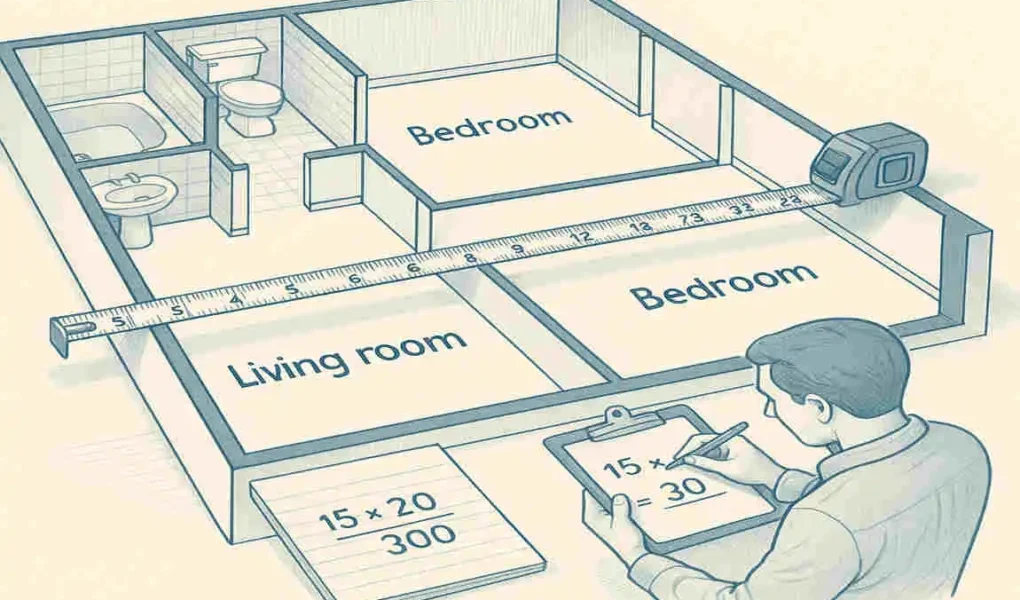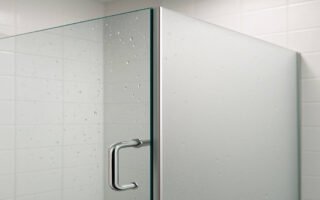Have you ever wondered why knowing your home’s exact size matters so much? Whether you’re selling your house, planning a remodel, or just curious about its value, accurate square footage can make a big difference. It influences everything from your home property taxes to how much buyers are willing to pay. And here’s a question that often arises: Are bathrooms included in square footage? If you’ve asked yourself that, you’re not alone—it’s a standard puzzle for homeowners.
We’ll also discuss local rules and when it’s advisable to call in the professionals. By the end, you’ll feel confident tackling this on your own. Ready to get measuring? Let’s start!
What is Square Footage in Real Estate?

Square footage might sound like a fancy term, but it’s really just a way to measure the space inside your home. Think of it as the total area you can actually use for living, working, or relaxing. We calculate it by multiplying the length and width of the rooms and adding them up. Simple.
But not all space counts the same way. There’s a big difference between usable living space—the cozy areas where you spend your time—and the total footprint, which includes everything under the roof, even unfinished spots. For example, your living room counts as usable, but a raw attic might not.
Why does this matter? Square footage plays a massive role in how much your home is worth. Real estate agents use it to price listings, and appraisers rely on it for valuations. If you’re selling, a higher square footage number can attract more buyers and drive up offers. Imagine two similar houses—one listed at 2,000 square feet and another at 1,800. Which one grabs your attention first?
In real estate, you’ll hear about different types of square footage. Heated square footage only includes areas with heating, like your main floors. Finished square footage covers spaces that are entirely done up, ready to live in. Then there’s gross square footage, which might include the whole building, walls and all. Each type serves a purpose, depending on whether you’re buying, selling, or getting a loan. Have you checked your home’s listing lately? It might surprise you how these labels affect the numbers.
Are Bathrooms Included in Square Footage?
Let’s tackle the big question head-on: are bathrooms included in square footage? The short answer is yes, in most cases. Bathrooms count as part of your home’s livable space because they’re essential rooms where you spend time daily. But it’s not always straightforward—it depends on the type of bathroom and how finished it is.
Full bathrooms, with a sink, toilet, shower, or tub, definitely get included. They add to the overall appeal and functionality of your home. Half bathrooms or powder rooms (just a sink and toilet) usually count too, as long as they’re finished and heated. These spaces aren’t just add-ons; they’re part of what makes a house feel complete.
What if your bathroom is unfinished or in a separate structure, like a detached guest house? That’s where things get tricky. An unfinished bathroom—with exposed pipes or no fixtures—might not count toward livable square footage. And if it’s in a separate building, it could be measured separately or excluded altogether, depending on local rules.
Real estate standards vary by region and appraisal company. In the U.S., organizations like the American National Standards Institute (ANSI) provide guidelines, but your local Multiple Listing Service (MLS) might have its own twists. For instance, in some states, basements with bathrooms only count if they’re above ground. This can impact your home’s value—buyers love extra bathrooms, and including them in the square footage makes your listing shine brighter. Have you ever skipped a house because it felt too small? Accurate inclusion of bathrooms could change that perception.
You may also read (the essential guide to choosing the right bathroom fixtures for home).
Ultimately, getting this right boosts your home’s marketability. A well-measured bathroom can add hundreds or even thousands to your appraisal. So, if you’re asking, “Are bathrooms included in square footage?”—yes, but always double-check with local experts to avoid surprises.
What Areas Are Typically Included or Excluded?
Figuring out what counts in square footage feels like solving a puzzle. Let’s clarify by breaking it into included and excluded spaces. This will help you visualize your own home.
Included areas are the heart of your living space. Bedrooms, living rooms, dining areas, kitchens, and yes—bathrooms—all typically cut if they’re finished and heated. Finished basements can count too, especially if they have livable features like a family room or extra bath. These spaces add real value because they’re where life happens.
On the flip side, excluded spaces are those that aren’t ready for everyday use. Garages, unfinished basements, attics, porches, balconies, and outdoor storage sheds usually don’t count. Why? They’re not considered livable under most standards. For example, a screened porch might be great for summer evenings, but it won’t boost your square footage.
Bathrooms fit squarely into the included category as long as they meet the finished, livable space criteria. They’re not like a garage—they’re indoor, functional rooms. To make this more straightforward, here’s a quick bulleted list of examples:
- Included: A main bedroom with an en-suite bathroom—measure the whole thing!
- Excluded: An unfinished attic storage area, even if it has plumbing potential.
- Included: A kitchen with an adjacent half bath—both add to the total.
- Excluded: A detached garage workshop, no matter how big.
See how that works? By focusing on livable areas, you get a more accurate picture of your home’s size. Next time you walk through your house, mentally note what’s in and what’s out—it might change how you see your space.
How to Measure Your Home’s Square Footage Including Bathrooms

Ready to roll up your sleeves and measure? Don’t worry—it’s easier than you think. We’ll walk through it step by step, including how bathrooms fit in. You’ll need some basic tools, and with a bit of patience, you’ll have accurate numbers.
Tools Needed and Preparation
Start by gathering your gear. A measuring tape or laser measure is essential for accuracy—lasers are great for long distances. Grab graph paper to sketch a floor plan, a calculator for math, and maybe a notepad for notes. Pro tip: Measure twice to avoid errors.
Prepare by outlining your home’s floor plan. Walk through each level and draw a rough sketch. Label rooms and note any irregularities, like bay windows. This blueprint will guide you and keep things organized.
Step-by-Step Measurement Guide
Now, measure each room individually. For a rectangular room, multiply length by width. Add up all rooms for the total. Include bathrooms right along with bedrooms and kitchens—they’re no different.
Handle irregular walls or open floor plans by breaking them into smaller shapes. For an L-shaped living room, measure each section separately and add them. Open plans? Imagine invisible lines dividing spaces.
Convert everything to square feet. If you measure in inches, divide by 144 (since 12 inches x 12 inches = 144 square inches per foot). Record measurements clearly—maybe in a spreadsheet—for easy reference.
Tips for Precision
Avoid common pitfalls like forgetting closets or rounding up too much—measure from wall to wall, including doorways. For multi-story homes, do one floor at a time. And remember, precision pays off—accurate numbers can mean a better sale price.
Here’s a numbered list for a smooth process:
- Clear clutter from rooms for easy access.
- Measure at floor level, ignoring baseboards.
- Double-check calculations with a partner.
- Use apps like MagicPlan for digital help if you’re tech-savvy.
By following these steps, you’ll confidently answer questions like “Are bathrooms included in square footage?” with your own data.
Special Considerations for Bathrooms
Bathrooms deserve their own spotlight because measuring them accurately can tip the scales in your home’s favor. They’re not just functional—they add luxury and value.
Accurate Measurement Techniques
Measure the whole room, including space around fixtures like sinks and tubs. Don’t subtract for the toilet or shower; count the entire floor area. For oddly shaped bathrooms, divide into rectangles and add up.
Full bathrooms versus half baths? Both count fully, but a full one might feel more valuable due to its size. Measure usable area, but include everything wall-to-wall.
Impact of Remodels and Expansions
Thinking of a remodel? Adding a bathroom or expanding an existing one directly increases the square footage of the property. For example, converting a closet into a powder room adds livable space. But if it’s an unfinished project, it won’t count yet.
What about adjacent closets or dressing areas? If they’re connected and finished, include them as part of the bathroom suite. This can make your master bath feel spa-like and boost the total.
Reader, have you remodeled lately? Measuring before and after shows the real impact—it’s motivating!
Using Professional Help vs DIY Measurement
Sometimes, DIY isn’t enough. When should you hire a pro? If you’re selling or refinancing, an appraiser ensures that your numbers align with industry standards.
Professionals bring accuracy and credibility. They follow guidelines like ANSI, making results accepted for listings. This is especially key for bathrooms, where minor errors add up.
Costs vary—expect $300–$500 for a basic appraisal. It’s worth it for peace of mind. To validate their work, request a detailed report and compare it to your DIY measurements, focusing on bathrooms and other challenging areas.
Why go pro? It avoids disputes with buyers. However, if you’re curious, a DIY approach works fine. Weigh your needs—what’s your situation?
Common Mistakes Homeowners Make When Calculating Square Footage
We all slip up sometimes. One big mistake? Accidentally excluding bathrooms, thinking they’re not “living” space. Remember, are bathrooms included in square footage? Yes—they are!
Another error: Confusing total footprint with livable area. You might include the garage, inflating numbers unrealistically.
Ignoring local MLS standards is risky, too—rules differ by area. And poor technique, such as mismeasuring sloped ceilings, leads to over- or underestimates.
Avoid these by staying informed. Double-check your work, and you’ll sidestep headaches.
How Square Footage Affects Home Value and Marketability
Accurate square footage isn’t just numbers—it’s money in your pocket. Including bathrooms can bump up your appraisal, as they signal comfort and convenience.
Buyers scan listings for size, and extra bathroom footage makes your home stand out from the crowd. Imagine a family loving the “spacious” feel from that included master bath.
In pricing, precise measurements help set competitive rates. Overstate it, and buyers walk; understate, and you lose cash.
For listings, clearly highlight bathrooms: “2,500 sq ft including three full baths.” It builds trust and excitement. How does your home stack up?
To illustrate, here’s a simple table comparing scenarios:
Scenario Square Footage Without Bathrooms Square Footage With Bathrooms Potential Value Impact
Small Home (2 beds, one bath) 1,200 sq ft 1,300 sq ft +5-10% appraisal boost
Family Home (4 beds, three baths) 2,200 sq ft 2,500 sq ft +10-15% buyer interest
Remodeled Home (added bath) 1,800 sq ft (pre) 2,000 sq ft (post) +15-20% market value
See the difference? It pays to include them correctly.
You may also read (things to know about shower door frosted glass for home).




